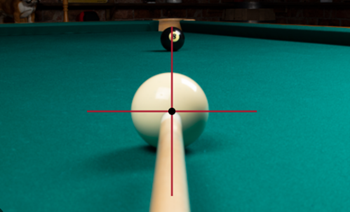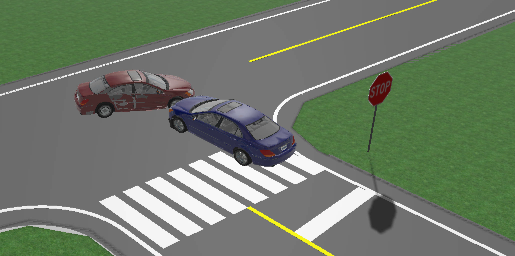Understanding How FARO MassZone Works
MassZone is a vehicle behavior and collision detection-response prediction system. MassZone allows you to automatically recreate accurate collision scenarios without requiring that you enter extensive amounts of crash data. This feature is especially useful for experimenting with collision scenarios.
To understand the principles of MassZone operation, it's important to familiarize yourself with some of the basic principles in crash reconstruction:
-
Kinematics - A branch of physics that studies the motions of bodies without any regard to the cause or mechanics of those motions. Kinematics is also known as ‘the geometry of motion’.
-
Kinetics: A branch of physics that studies the causes of the motions of bodies; specifically the forces and torques that cause a body to change motion. Kinetics is also referred to as 'dynamics'.
-
Motion: A combination of movement (velocity) and rotation properties. Some regard velocity and speed as different factors. In MassZone, the concepts are interchangeable.
-
Body: An object (such as a vehicle).
-
COG: Center of Gravity
In FARO Zone 3D, the animation system and momentum tool controls are kinematics-based. You provide the path and velocities of the bodies along a designated path with no regard to the forces that caused them. In the KEP Manager, you specify the path of the COG and the speed and orientation along that path at designated keypoints. The animation kinematics system interpolates the path to determine a body’s location and orientation at a specific time, which allows the software to display the results in the animation.
MassZone, is a kinetics-based system. No event occurs in MassZone without a force that causes it. (There are a few exceptions for initial scenario conditions and setup.) MassZone is based on the principals of Newton's Laws of Motion, which are summarized as follows:
-
Law of Inertia: A body at rest remains at rest, or a body in constant motion remains in constant motion unless it is acted upon by an external force.
-
Law of Proportional Force: A body’s change in motion (or momentum) is proportional to the force acting upon it. Force=Mass*Acceleration, or Acceleration=Mass/Force. F=M*A, A=M/F
-
Law of Action/Reaction: For every action, there is an equal and opposite reaction. If a force interacts upon two bodies, they will be equal (in magnitude) and opposite (in direction). F*BodyA = -F*BodyB
MassZone integrates with FARO Zone's animation functionality. You enter the initial motion of the bodies in the kinematics-based animation system. When a collision occurs, MassZone automatically calculates all of the body motion using a kinetics-based system.
MassZone vs Momentum-based systems
Unlike typical momentum analysis systems, MassZone does not use ‘point-mass’ assumptions. MassZone treats a body as a full area/volume mass that takes up space, and has a COG associated with it. The locations, and the directions of forces acting upon the body are important.

A force acting upon a body's Center of Mass results in a different motion than the same force (magnitude and direction) that acts at a distance from the Center of Mass.

In MassZone, collisions occur over a time span. No instantaneous exchange of momentum occurs. All collision forces calculate over time, resulting from the deformation of the bodies as the bodies remain in contact. Collision forces are calculated along the entire interface between the two bodies as they deform; not at a single engagement point.

The collision interface between the two bodies also changes over time as the bodies deform and their motions change. Parts of the bodies leave contact, as other parts come into contact. The changes to the body parts that impact one another changes the collision interface over time.
There is an exception: MassZone allows for a “Rigid Body” specification. By default, bodies deform upon impact. Some rigid bodies (for example, concrete barriers) do not deform when impacted. When a soft body impacts a rigid body, collision still occurs over a period of time. In the case of a rigid body impacting another rigid body, a rigid body dynamics system is employed, which allows for an instantaneous collision impulse.
Currently MassZone is a 2D/Planar that displays in 3D (aka a 2.5D system). Vehicles and scenes are represented in 3D, but all motions and force predictions are based on flat, level planes. No vertical motion, gravity, forces, or rotations are considered for reasons other than visual appeal. Collision forces between bodies are uniform through the entire vertical dimension of the body’s 3D volume. This is consistent with most accident reconstruction techniques and teachings. Future versions of MassZone will include full 3D force considerations, including gravity, vault, lift, 4-wheel suspension, terrain elevation changes/bumps, inclines/declines, 3D volumetric crush/damage and 3D collision forces.
In MassZone - outside of a collision impulse and/or initial conditions/setup - all body motion is generated by tire-surface forces. Each tire on the body generates a force with the underlying surface. This force causes the body to change its motion (accelerate, decelerate, turn). The forces from the tires cause the body’s Center of Mass to move; not vice-versa. The vehicle's transaxle (front-wheel drive, rear-wheel drive or all-wheel drive) results in different motions under the same conditions and tire parameters. All of the vehicle's related parameters (front overhang, wheelbase, trackwidth, Center of Mass, offset, etc.) are important, and they change the resulting motions. MassZone allows you to define different surface friction areas for each of the vehicle's tires.
MassZone Features
-
Include multiple vehicles in the collision
-
Display multiple impacts
-
Show fixed barrier/pole impacts
-
Include multiple friction surfaces
-
User steering inputs
-
Manual
-
Real time device driven input
-
Support for input from multiple devices, including: Steering Wheel Device + Brake/Accelerator Pedal, keyboard, 3D mouse, Gamepad.
-
Use Animation Path for ‘Force Independent’ controlled pre-impact trajectory pathing
-
Real-Time Driver Mirror Views option
Future MassZone Functionality (Features that are currently not supported in MassZone)
These features are not currently included in MassZone, but will be added in upcoming releases:
-
2D mode (currently 3D mode only)
-
2D models
-
2D symbols support
-
Shapes
-
2.5D (all calculations are assuming Planar 2D)
-
Gravity and elevation calculations
-
Roll over/pitch calculations
-
Vehicles other than those with 4 wheels (standard/passenger vehicles only)
-
Articulated vehicles, including tractor trailers, commercial vehicles, vehicles pulling trailers, etc.
-
Humans, animal models
-
Anibuddies or grouped models or symbols
-
Collision detection/damage response becomes unstable with high penetration scenarios, or after a large amount of damage has already occurred
-
Very high-speed impacts
-
Small cross section impacts
-
Only supports a uniform A/B Stiffness coefficient for each vehicle
-
Collision detection response is based on 2D Outline (shell) of bodies only
-
Fixed barriers/poles are treated as rigid objects and are considered completely immovable and cannot be deformed
MassZone Special Considerations
Vehicle trajectory predictions are highly-dependent on Ground Friction values, Tire Slip values, Tire Stiffness values and Tire Angle (slip angle/steering angle) values
Scenarios where tires leave, or have reduced contact, with the surface are not currently handled. Tires are assumed to always have full contact with the surface.
No vehicle weight shift is calculated.
